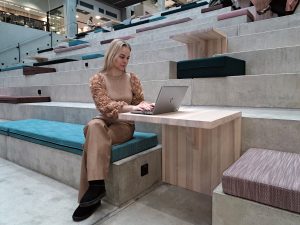Priita Isokääntä aloitti Turun ammattikorkeakoulussa liiketalouden tradenomiopinnot syyskuussa 2023. Turun ammattikorkeakoulu tarjoaa BBA-tutkinnon myös täysin etänä sekä englanniksi. Kymmenen vuotta…
Kirjoittajat
Virtual Services for Migrants are Being Developed
The number of migrants in Finland has increased and continues to grow. Their integration will be helped in many ways, but language skills are often a barrier to accessing services, education, and employment. Therefore, the development of multilingual services is of paramount importance to help them.
The number of migrants in Finland has increased in recent years. This can also be seen in Southwest Finland. When public services are organized, it is important to consider their needs.
For migrants to integrate quickly, they should be provided with measures, services, and training to promote integration. The problem that underlies lack of access to services and jobs is often actually a lack of language skills.
The answer to this problem is now being sought through the development of multilingual digital services offered in a virtual environment.
The Early Prototype Is Ready
During the summer we started to develop an application that will serve as a virtual service for migrants. Since most immigrants have a mobile phone, we chose it as the platform.
The initial prototype of the application is now finished. It is by no means complete, but rather offers a visual representation of its potential use cases.
The application’s design can be divided into three categories: AI translations, information hub and virtual rooms.
AI Translations: With the help of AI, we believe the app can support +50 different languages. This means both the application’s language itself, plus real time speech-to-text and text-to-speech translations.
Information Hub: The hub aims to gather all the information under the same roof that currently exists on numerous different websites. When we use artificial intelligence to scan input data, we simplify users’ access to the data. At the same time, we ensure the reliable use of the data.
Virtual Rooms: In a 3D environment, multiple users can communicate with each other. Rooms can serve as a platform for various existing services and as a social meeting place for migrants and advisors. For instance, Sateenkaari Koto’s learning home can be a prime example of a virtual environment. You can see what users can do there in real life. Virtual rooms open new possibilities for community-building across geographical boundaries.
The Key Role Is Language Services
The application is designed to be modular. For example, it allows the source material to be automatically updated within the data centre, and virtual rooms can be added as needed. This flexibility ensures that the application will serve all project partners and perhaps other interested parties in the future.
Our intention is not to replace existing services, but to supplement them with virtual communication and access to information. Language services play a key role in all of this, as they ensure that the information in the application is available in the user’s native language.
During this development process, challenges have arisen in terms of accessibility, user experience, usability, and the consolidation of existing knowledge. We solved the challenges like this:
- accessibility is ensured through mobile devices. It is possible to do desktop integration at a later stage of development.
- user experience and usability are highlighted with clear visual cues and icons.
- AI is used to streamline processes and improve user experience.
The Development Work Continues
Next, we review the feedback collected from the end users and check how well the current design fits the needs. If necessary, we will change the design.
We definitely benefit from the expertise of our project partners. As the development progresses, we will continue to work closely with both project partners and end users to ensure the success of the application.
In conclusion, VINCE represents how virtual solutions can create genuine positive change in the lives of individuals and organizations alike.
Virtual Integration Home – Promoting Inclusion and Empowerment Digitally (VINCE)
VINCE is a collaborative effort that brings together expertise from both Finland and Sweden. At its core, the VINCE project is committed to providing virtual solutions that empower migrants, make information more accessible, and support their integration into new societies.
Link to the VINCE project’s webspace: https://www.tuas.fi/en/research-and-development/projects/virtual-integration-home-promoting-inclusion-and-e/
This article is part of the Social Inclusion and Active Citizenship and Futuristic Interactive Technologies research groups’ activities.



